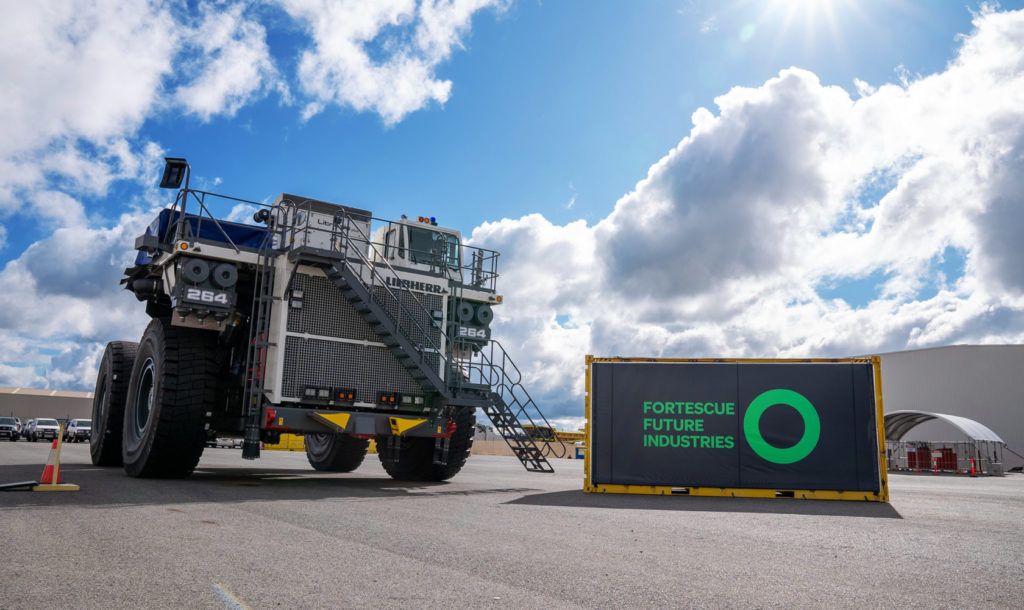Fortescue to spend $6.2bn to rid iron ore ops of fossil fuels by 2030
Reuters |

Credit: Fortescue Future Industries
Australia’s Fortescue Metals Group said on Tuesday it would spend an estimated $6.2 billion to eliminate the use of fossil fuels and achieve “real zero terrestrial emissions” across its iron ore operations by the end of the decade.

The investment includes the Perth-based miner installing an additional 2-3 gigawatts of renewable energy generation and battery storage, as well as incremental costs associated with beefing up its green mining fleets and locomotives.

Largely planned in fiscal years 2024 to 2028, the investment will enable displacement of about 700 million litres of diesel and 15 million gigajoules of gas per annum by 2030, and prevent emission of 3 million tonnes of carbon dioxide equivalent per year, the miner said.
The world’s fourth-largest iron ore producer anticipates cumulative operational savings of $3 billion by 2030 with payback on investment by 2034, and expects to save $818 million in costs per year from 2030 onwards.
Real zero terrestrial emissions refer to direct and indirect emissions from the firm’s operations and from generation of purchased electricity, steam, among others.
Fortescue and its green-energy unit Fortescue Future Industries (FFI) are trying to rapidly develop infrastructure and technology to produce green hydrogen, as the miner transitions from a pure-play iron ore producer to a green energy firm.
The miner, led by chairman and iron ore magnate Andrew Forrest, has chalked in $600 million to $700 million in capital expense for FFI in fiscal 2023 to build a full green hydrogen supply chain by the end of the decade, potentially positioning itself as a key player in supply of the alternate fuel.
“There’s no doubt that the energy landscape has changed dramatically over the past two years and this change has accelerated since Russia invaded Ukraine,” Forrest said on Tuesday.
The miner expects “attractive economic returns” on operating cost savings after eliminating diesel, natural gas, and carbon offset purchases from its supply chain, it added.
(By Sameer Manekar; Editing by Maju Samuel)
Reuters |

Credit: Fortescue Future Industries
Australia’s Fortescue Metals Group said on Tuesday it would spend an estimated $6.2 billion to eliminate the use of fossil fuels and achieve “real zero terrestrial emissions” across its iron ore operations by the end of the decade.

The investment includes the Perth-based miner installing an additional 2-3 gigawatts of renewable energy generation and battery storage, as well as incremental costs associated with beefing up its green mining fleets and locomotives.

Largely planned in fiscal years 2024 to 2028, the investment will enable displacement of about 700 million litres of diesel and 15 million gigajoules of gas per annum by 2030, and prevent emission of 3 million tonnes of carbon dioxide equivalent per year, the miner said.
The world’s fourth-largest iron ore producer anticipates cumulative operational savings of $3 billion by 2030 with payback on investment by 2034, and expects to save $818 million in costs per year from 2030 onwards.
Real zero terrestrial emissions refer to direct and indirect emissions from the firm’s operations and from generation of purchased electricity, steam, among others.
Fortescue and its green-energy unit Fortescue Future Industries (FFI) are trying to rapidly develop infrastructure and technology to produce green hydrogen, as the miner transitions from a pure-play iron ore producer to a green energy firm.
The miner, led by chairman and iron ore magnate Andrew Forrest, has chalked in $600 million to $700 million in capital expense for FFI in fiscal 2023 to build a full green hydrogen supply chain by the end of the decade, potentially positioning itself as a key player in supply of the alternate fuel.
“There’s no doubt that the energy landscape has changed dramatically over the past two years and this change has accelerated since Russia invaded Ukraine,” Forrest said on Tuesday.
The miner expects “attractive economic returns” on operating cost savings after eliminating diesel, natural gas, and carbon offset purchases from its supply chain, it added.
(By Sameer Manekar; Editing by Maju Samuel)
No comments:
Post a Comment